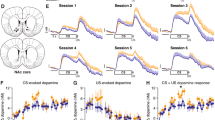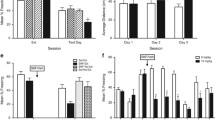Abstract
Rationale
Learning the association between rewards and predictive cues is critical for appetitive behavioral responding. The mesolimbic dopamine system is thought to play an integral role in establishing these cue–reward associations. The dopamine response to cues can signal differences in reward value, though this emerges only after significant training. This suggests that the dopamine system may differentially regulate behavioral responding depending on the phase of training.
Objectives
The purpose of this study was to determine whether antagonizing dopamine receptors elicited different effects on behavior depending on the phase of training or the type of Pavlovian task.
Methods
Separate groups of male rats were trained on Pavlovian tasks in which distinct audio cues signaled either differences in reward size or differences in reward rate. The dopamine receptor antagonist flupenthixol was systemically administered prior to either the first ten sessions of training (acquisition phase) or the second ten sessions of training (expression phase), and we monitored the effect of these manipulations for an additional ten training sessions.
Results
We identified acute effects of dopamine receptor antagonism on conditioned responding, the latency to respond, and post-reward head entries in both Pavlovian tasks. Interestingly, dopamine receptor antagonism during the expression phase produced persistent deficits in behavioral responding only in rats trained on the reward size Pavlovian task.
Conclusions
Together, our results illustrate that dopamine’s control over behavior in Pavlovian tasks depends upon one’s prior training experience and the information signaled by the cues.








Similar content being viewed by others
References
Coddington LT, Dudman JT (2018) The timing of action determines reward prediction signals in identified midbrain dopamine neurons. Nat Neurosci 21:1563–1573
Day JJ, Roitman MF, Wightman RM, Carelli RM (2007) Associative learning mediates dynamic shifts in dopamine signaling in the nucleus accumbens. Nat Neurosci 10:1020–1028
Di Ciano P, Cardinal RN, Cowell RA, Little SJ, Everitt BJ (2001) Differential involvement of NMDA, AMPA/kainate, and dopamine receptors in the nucleus accumbens core in the acquisition and performance of pavlovian approach behavior. J Neurosci 21:9471–9477
Eyny YS, Horvitz JC (2003) Opposing roles of D1 and D2 receptors in appetitive conditioning. J Neurosci 23:1584–1587
Fiorillo CD, Tobler PN, Schultz W (2003) Discrete coding of reward probability and uncertainty by dopamine neurons. Science 299:1898–1902
Flagel SB, Clark JJ, Robinson TE, Mayo L, Czuj A, Willuhn I, Akers CA, Clinton SM, Phillips PE, Akil H (2011) A selective role for dopamine in stimulus-reward learning. Nature 469:53–57
Fonzi KM, Lefner MJ, Phillips PEM, Wanat MJ (2017) Dopamine encodes retrospective temporal information in a context-independent manner. Cell Rep 20:1765–1774
Fraser KM, Janak PH (2017) Long-lasting contribution of dopamine in the nucleus accumbens core, but not dorsal lateral striatum, to sign-tracking. Eur J Neurosci 46:2047–2055
Fraser KM, Haight JL, Gardner EL, Flagel SB (2016) Examining the role of dopamine D2 and D3 receptors in Pavlovian conditioned approach behaviors. Behav Brain Res 305:87–99
Gan JO, Walton ME, Phillips PE (2010) Dissociable cost and benefit encoding of future rewards by mesolimbic dopamine. Nat Neurosci 13:25–27
Hart AS, Clark JJ, Phillips PEM (2015) Dynamic shaping of dopamine signals during probabilistic Pavlovian conditioning. Neurobiol Learn Mem 117:84–92
Heymann G, Jo YS, Reichard KL, McFarland N, Chavkin C, Palmiter RD, Soden ME, Zweifel LS (2020) Synergy of distinct dopamine projection populations in behavioral reinforcement. Neuron 105(909–920):e5
Horvitz JC (2001) The effects of D1 and D2 receptor blockade on the acquisition and expression of a conditioned appetitive response. Appetite 37:119–120
Khoo SY, Uhrig A, Samaha AN, Chaudhri N (2021) Effects of dopamine receptor antagonism and amphetamine-induced psychomotor sensitization on sign- and goal-tracking after extended training. Behav Brain Res 407:113238
Lee K, Claar LD, Hachisuka A, Bakhurin KI, Nguyen J, Trott JM, Gill JL, Masmanidis SC (2020) Temporally restricted dopaminergic control of reward-conditioned movements. Nat Neurosci 23:209–216
Lefner MJ, Dejeux MI, Wanat MJ (2022) Sex differences in behavioral responding and dopamine release during Pavlovian learning. eNeuro 9(2):ENEURO.0050-22.2022. https://doi.org/10.1523/ENEURO.0050-22.2022
Lopez JC, Karlsson RM, O’Donnell P (2015) Dopamine D2 modulation of sign and goal tracking in rats. Neuropsychopharmacology 40:2096–2102
Morrens J, Aydin C, Janse van Rensburg A, Esquivelzeta Rabell J, Haesler S (2020) Cue-evoked dopamine promotes conditioned responding during learning. Neuron 106(142–153):e7
Phillips PE, Walton ME, Jhou TC (2007) Calculating utility: preclinical evidence for cost-benefit analysis by mesolimbic dopamine. Psychopharmacology 191:483–495
Roesch MR, Calu DJ, Schoenbaum G (2007) Dopamine neurons encode the better option in rats deciding between differently delayed or sized rewards. Nat Neurosci 10:1615–1624
Roughley S, Killcross S (2019) Differential involvement of dopamine receptor subtypes in the acquisition of Pavlovian sign-tracking and goal-tracking responses. Psychopharmacology 236:1853–1862
Salamone JD, Correa M (2012) The mysterious motivational functions of mesolimbic dopamine. Neuron 76:470–485
Saunders BT, Robinson TE (2012) The role of dopamine in the accumbens core in the expression of Pavlovian-conditioned responses. Eur J Neurosci 36:2521–2532
Schultz W, Dayan P, Montague PR (1997) A neural substrate of prediction and reward. Science 275:1593–1599
Sculfort SA, Bartsch D, Enkel T (2016) Dopamine antagonism does not impair learning of Pavlovian conditioned approach to manipulable or non-manipulable cues but biases responding towards goal tracking. Behav Brain Res 314:1–5
Stelly CE, Tritley SC, Rafati Y, Wanat MJ (2020) Acute stress enhances associative learning via dopamine signaling in the ventral lateral striatum. J Neurosci 40:4391–4400
Stelly CE, Girven KS, Lefner MJ, Fonzi KM, Wanat MJ (2021) Dopamine release and its control over early Pavlovian learning differs between the NAc core and medial NAc shell. Neuropsychopharmacology 46:1780–1787
Tobler PN, Fiorillo CD, Schultz W (2005) Adaptive coding of reward value by dopamine neurons. Science 307:1642–1645
Wassum KM, Ostlund SB, Balleine BW, Maidment NT (2011) Differential dependence of Pavlovian incentive motivation and instrumental incentive learning processes on dopamine signaling. Learn Mem 18:475–483
Funding
This work was supported by National Institutes of Health grants DA033386 (MJW), DA042362 (MJW), and DA051014 (MJW).
Author information
Authors and Affiliations
Contributions
MJL, CES, KMF, and HZ performed the experiments and analyzed the data. MJW designed the experiments. MJL and MJW wrote the manuscript.
Corresponding author
Ethics declarations
Conflict of interest
The authors declare no competing interests.
Additional information
Publisher's note
Springer Nature remains neutral with regard to jurisdictional claims in published maps and institutional affiliations.
Supplementary Information
Below is the link to the electronic supplementary material.
Rights and permissions
About this article
Cite this article
Lefner, M.J., Stelly, C.E., Fonzi, K.M. et al. Critical periods when dopamine controls behavioral responding during Pavlovian learning. Psychopharmacology 239, 2985–2996 (2022). https://doi.org/10.1007/s00213-022-06182-w
Received:
Accepted:
Published:
Issue Date:
DOI: https://doi.org/10.1007/s00213-022-06182-w




